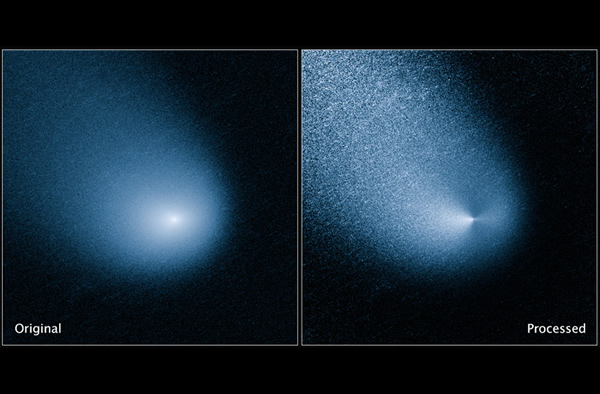Hubble Zooms-in on Mars-Buzzing Comet Siding Spring
Hubble image of comet C/2013 A1 (Siding Spring), before and after processing. Credit: NASA, ESA, and J.-Y. Li (Planetary Science Institute)
This fall, on Oct. 19, a comet will blast past Mars at a distance of only 86,000 miles (138,000 kilometers) — a little more than one-third the average distance between Earth and the moon. NASA is anticipating the event as a great viewing opportunity for its Red Planet robot residents (as is ESA) but until then all the action will be captured by Earthbound telescopes, including the orbiting Hubble Space Telescope, which acquired the image above on March 11.
Showing the 12,000-mile (over 19,000 km) wide coma of comet C/2013 A1 — aka Comet Siding Spring, after the observatory in Australia where astronomer Robert McNaught first spotted it last year — the Hubble image has been processed to better discern what appear to be two separate jets coming out of opposite ends of its nucleus.
Measurements of these jets will help astronomers determine the rotation of Siding Spring’s nucleus, an important factor for comets as that can affect their appearance, orbits, and even whether or not they hold together at perihelion — the closest approach to the sun.
Siding Spring will reach its perihelion on Oct. 25, six days after its pass of Mars, at a distance of 1.399 AU (130 million miles / 209.2 million km). After that it will head back out into the depths of the solar system, continuing its million-year-long journey around the sun.
The Hubble image was captured when Siding Spring was within the orbit of Jupiter, about 353 million miles (568 million km) away.
While it’s not thought that this comet will become visible to the naked eye from here on Earth, it could put on a great show for spacecraft at Mars. In fact at one point it was thought that Siding Spring might even hit Mars! Further calculations showed that wouldn’t be the case, but arriving at that conclusion wasn’t easy — determining the orbits of comets is harder than it sounds. Observations like the one shown above are crucial to figuring out the exact trajectories of these icy cosmic callers. After all, a few decimal places can make the difference between a hit or a miss, and one day it might well be be our own planet on the line.(Mar 27, 2014 02:00 PM ET // by Jason Major)












